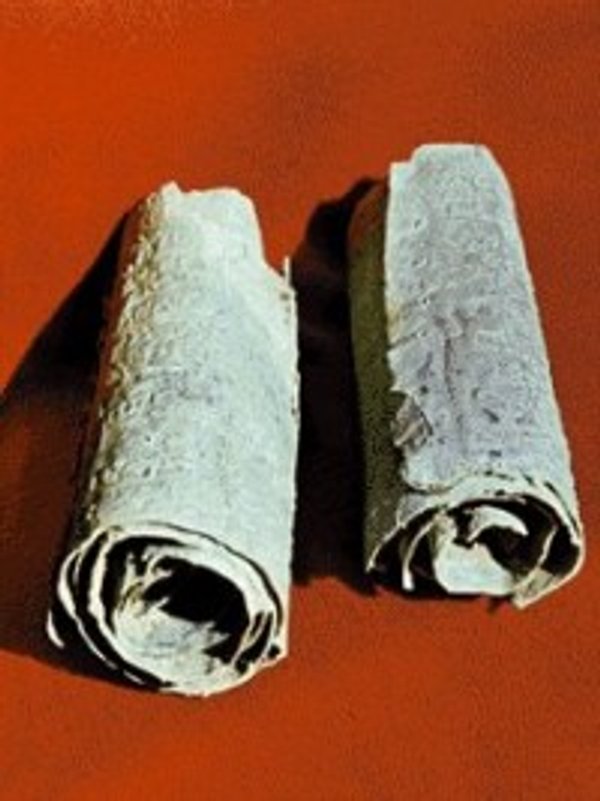● In 1947, two Bedouin shepherds accidentally came across a clay jar containing seven parchment scrolls in a cave in the Wadi Qumran, beside the Dead Sea. Subsequently, many scrolls and thousands of fragments were found in 11 caves, written in Hebrew, Aramaic and Greek. It is believed that they were composed between the 2nd century BC and the year 70 AD, the year of the destruction of Jerusalem.
● Some 800 writings have been reconstructed from among several thousand fragments, since very few complete documents have been recovered. There are fragments from every book of the Old Testament, with the exception of the Book of Esther, from the many already known non-canonical Jewish books and even from some, until then, unknown books, and several writings belonging to the Essenes, a sect which had withdrawn to the desert.
● Undoubtedly, the most important documents are the Bible texts. Until the discovery of the Qumran texts, the earliest Hebrew manuscripts we possessed dated from the 9th and 10th centuries AD. Consequently, it was natural to suspect that uncomfortable words or phrases featuring in the original texts had been defaced, lengthened or modified.
► The discoveries prove that the original texts coincide with their medieval counterparts – despite dating from almost 1,000 years earlier.
► The few disparities they present match to a great extent some already authenticated by the Greek version, known as the Septuagint, or by the Samaritan Pentateuch. Several other documents have helped demonstrate that there were other ways of interpreting Scripture (and legal norms) different to that common among Sadducees and Pharisees.
● There are no New Testament texts or Christian writings of any kind among the Qumran texts. At some point, there was a discussion about whether some Greek words on two small fragments of papyrus found there belonged to the New Testament, but it seems not to be the case. This aside, further possibilities of finding Christian documents in those caves have been ruled out.
● Neither does it seem that the New Testament contains any influence from the Jewish texts found there. Today, experts agree that in the doctrinal sphere, Qumran did not have any influence upon the origins of Christianity, for the minority Dead Sea Sect had cut themselves off from society, while Jesus and the first Christians were immersed in the Jewish society of their time and were in touch with the people.
► The documents have served solely to clarify some common terms and expressions of that period which were proving difficult to understand today, and to comprehend better the extremely pluralist Jewish environment into which Christianity was born.
● During the first half of the 1990’s, two great myths (now dismissed) were in circulation. One claimed that the manuscripts contained doctrines that contradicted Judaism or Christianity and that consequentially the Chief Rabbinate and the Vatican had come to an agreement to prevent their publication. All the documents are now published, and it is clear that far from being of a religious kind, the publication difficulties encountered were of a scientific nature.
► The second myth is more convincing, because it was apparently backed by science. Barbara Thiering, a university professor from Sydney and Robert Eisenman, a California State University professor, published several books comparing the Qumran documents with the New Testament, through which they came to the conclusion that both were written in code and cannot be interpreted literally, but rather have a secret significance which must be deciphered.
– They suggest that the founder of the Qumran group may have been John the Baptist and his adversary, Jesus (according to Thiering), or that the Teacher of Justice may have been James and his rival, Paul. They based their theories on the fact that in the texts, reference is made to people using unfamiliar terminology which is meaningless to us, such as Teacher of Justice, Impious Priest, The Deceitful, Furious Lion, sons of light and sons of darkness, the house of abomination, etc.
– Today the experts accept no such claims. If we do not yet understand the scope of this terminology, it is not due to its containing esoteric doctrines. It is obvious that the Qumranites’ contemporaries were familiar with these expressions and that even if the Dead Sea scrolls contain doctrines and norms that differ from those upheld by official Judaism, they have no secret key and do not conceal unspeakable theories.
